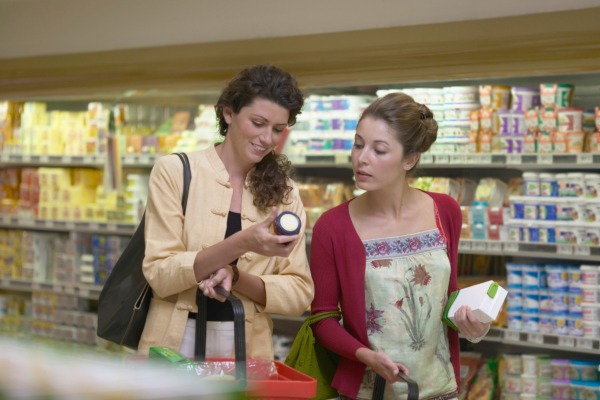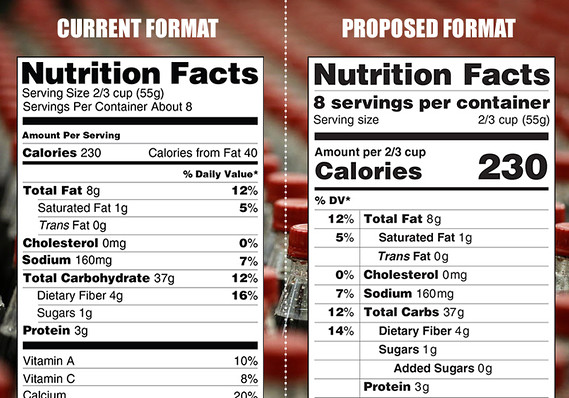
Over the last two decades, we have become accustomed to reading labels on food and thinking we understand precisely what it all means. We’ve almost become our own self-made nutritionists.
It’s fair to say that our general knowledge of what’s healthy and what’s unhealthy has undoubtedly gone up. We have changed from fearing fat in avocados to understanding that they carry good fats for the body, and we have gone from thinking sodas were fine and in fact quite cool to demonising sugar and it’s a correlation to obesity and diabetes without so much as a second thought.
Now after many years of being discussed at the highest level of the governing bodies of food and beverages throughout the Western world things are finally changing.
Relabelling of Products:
The governing body in the USA the FDA (U.S. Food and Drug Administration) is now bringing out new informative labelling to in a way showcase what we have learned through rigorous scientific research into food and drink over the past twenty years, as when you think about it, the labelling we look at was conceived decades ago!
The new labelling in the US was passed in 2016 and has already gone onto certain goods and products throughout the country, and they anticipate it will have full coverage by 2021. The label itself is not groundbreakingly different to the old ones so you won’t need a science degree to work out what to put in your shopping basket or leave on the shelf, but not all the changes will result in helping you attain your weight-loss goals, especially if you are misreading the labels.
Taking a Label to a Table
Here we take a look at the changes to the labels and look to give some useful tips when reading them to ensure you don’t overeat and the labels end up having the opposite effect.
Calories – There’s more to it than just calories
All new labelling focuses heavily on three factors:
∙ Calories
∙ Serving Size
∙ Servings per container
All of these are listed in bigger and bolder fonts. The FDA’s thinking behind this was to make it faster and more convenient to decide to take it or leave it on the shelf at a glance.

Calories are the easiest denominator for basic weight-loss, so fewer calories are the easy part. But for those in the know calorie control alone does not drop inches from around the waist for many people.
Some people can misinterpret fewer calories means automatic weight-loss. This cannot be the case for many as each may be on a different plan and have different eating behaviours need more calories, so just because calories are easy to see on a label that shouldn’t be all you considering weight-loss.
Quality calories are the key to eating healthy.
Portion Size and Serving Size – Don’t Get Confused
The FDA has an understanding that people are confused so the new labelling will reflect how much you have consumed rather than try to guide on how much you should consume.
Here’s some example so you can read between the lines:
∙ If a serving size on the old labelling for ice cream was half a cup the new labels will show 2/3 of a cup
∙ A muffin cake that was previously labelled two servings will now be one.
However the goal is to re-list them in more realistic quantities but what people will need to understand is that you are to eat the serving size that is listed, this is the common mistake.
Correct portion sizes are different for everyone, for example, someone who is active in the gym has an entirely different dynamic of calorie intake to someone is who is not. Unfortunately, the new labelling won’t help you decipher any nutritional advice for what’s right for you.
However here’s a rough guide to help you out to visualise what the label means when you are shopping:
A serving of meat – same size as a bar of soap
A serving of pasta – same size as your fist
A serving of butter – same size as you thumbnail
A serving of cheese is the same size as a poker dice
Keep this in mind and use it as a guide.
Stop binging – Think ‘per package’
Whereas old labelling made you feel like you could eat the whole package in one sitting, now there is a dual column and listed are ‘per package’ and ‘per serving.’
So on the one hand if you eat it all, then there’s no need to have to calculate anything if you are on a controlled diet. It’s there in black and white.
Though this can be quite a slap in the face to those of you, who eat a whole bag of chips and drink a large Coke while watching your favourite soap on the TV. (850 plus 250 calories in one sitting ouch!).
The way they have worked is to leave oversized packages that you should know are clearly not one serving, ie. More like three servings to just one column, not two.
Sugars are now labelled – Rejoice
The one positive move seen by the dietician nutritionist and naturopath community is finally a realistic sugar level content labelling. If there are ‘added sugars’ they will be labelled, the manufacturers can’t hide behind clever advertising anymore.
Before they could hide artificial sugars as natural the same as fructose in fruit for example, so all sugar came under one pretence.
The FDA has made this a thing of the past. They demand the manufacturers include percentages and grams plus the percentage of the daily intake value.
Moreover, natural foods like cranberry products or honey that are pure contain an ‘x’ symbol and a statement to explain these are not ‘added sugars’ and exactly what ‘added sugars’ are.
So this is a step in the right direction, as previously they could hide behind a myriad of clever and confusing names such as:
Sucrose
Cane Juice
Fructose
Fructose Corn Syrup
The list is endless, almost 50 differing names were used in the last two decades.
So the goal of the FDA was for people’s intake of sugar to go down without tarnishing natural sugars with the same brush.
Science has shown us direct relations between obesity and sugar leading to a plethora of medical issues, so from a government perspective, especially those in the UK and Australia for example where health care is not through insurance a reduction in obesity is a big thing.
As a rough guide sugar should be no more than 10 per cent of your calorie intake on a daily basis:
So a standard 2000 calorie a day diet = 200 calories from sugar = 50 grams (each gram containing 4 calories).
Identifying Good fats from Bad fats
Science and education are finally giving us the distinction of knowing for example as I mentioned before avocados, nuts and salmon, for example, are good. So time to let go of the phobia of fat and understand it’s not the amount, it’s the fat itself that matters regarding daily intake and weight loss.
So in 2018, we are familiar with the fact that monounsaturated and polyunsaturated fats are good for us, and saturated fats and Trans fats are bad for us.
The new labelling is quite distinct when it comes to this and ‘calories from fat’ has disappeared to be replaced with ‘total fat’ ‘trans-fat’ and ‘saturated fat’. So when looking at your label, you know what to avoid (especially trans-fat).
Conclusion
The new labelling will be widespread across all products in all developed countries by 2021, and although not perfect there has been a long-drawn-out thought process that has gone into this and finally some distinction about what we are putting into our bodies. If you are still unsure, then take time out to see a nutritionist or Naturopath discuss what’s best for you. But at least that shopping basket should be containing less sugar and bad fats and some healthier options when that label hits your table.
Author Bio:
 Paul Johnson is a freelance writer with over 16 years’ experience in writing about health and fitness, and nutrition is currently posting regularly about Wellness and Naturopathy with Merridy Casson who is also a registered nutritionist Adelaide.
Paul Johnson is a freelance writer with over 16 years’ experience in writing about health and fitness, and nutrition is currently posting regularly about Wellness and Naturopathy with Merridy Casson who is also a registered nutritionist Adelaide.















